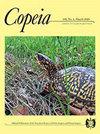来自西澳大利亚和日本南部的两个假菊属新种及假菊属的重新描述(Teleostei:Labridae)
IF 2.6
Q2 Agricultural and Biological Sciences
引用次数: 1
摘要
反赤道labrid Pseudojuloides elongatus在西太平洋和东印度洋分布广泛但不连续,种群分布在西澳大利亚、日本南部和西南太平洋。形态特征的主成分分析和线粒体和核DNA标记的基于聚结的物种树估计表明,这些种群正处于分化的初始阶段。这三个异父系种群在两性的着色模式上有很大差异,尤其是在终末期雄性中,这暗示着生殖隔离。在澳大利亚东部和诺福克岛的9个副型和2个附加标本的基础上,我们重新描述了长形假蛛,并描述了两个新种,即西澳大利亚的假蛛(Pseudojuloides crucus)新种和日本南部的paradiseus(P.paradiseus)新种。该复合体与该属其他成员的区别在于共有以下特征组合:身体细长;背鳍射线IX,12;胸鳍射线12;没有正中额前量表;通常为27个侧线刻度。我们简要评述了西印度洋的反赤道生物地理格局和银纹假钻。本文章由计算机程序翻译,如有差异,请以英文原文为准。
Two New Species of Pseudojuloides from Western Australia and Southern Japan, with a Redescription of Pseudojuloides elongatus (Teleostei: Labridae)
The anti-equatorial labrid Pseudojuloides elongatus has a wide but disjunct distribution across the Western Pacific and Eastern Indian Oceans, with populations occurring in Western Australia, southern Japan, and the southwest Pacific Ocean. Principal component analysis of morphological characters and coalescent-based species-tree estimates of mitochondrial and nuclear DNA markers suggest that these populations are under incipient stages of divergence. The three allopatric populations differ strongly in coloration patterns of both sexes, particularly in terminal males, suggestive of reproductive isolation. We redescribe Pseudojuloides elongatus on the basis of nine paratypes and two additional specimens from eastern Australia and Norfolk Island, and describe two new species, Pseudojuloides crux, new species, from Western Australia, and P. paradiseus, new species, from southern Japan. The complex is distinguished from other members of the genus in sharing the following combination of characters: body elongate; dorsal-fin rays IX,12; pectoral-fin rays 12; no median predorsal scales; and usually 27 lateral-line scales. We briefly comment on anti-equatorial biogeographical patterns and Pseudojuloides argyreogaster from the Western Indian Ocean.
求助全文
通过发布文献求助,成功后即可免费获取论文全文。
去求助
来源期刊

Copeia
生物-动物学
CiteScore
2.10
自引率
0.00%
发文量
0
审稿时长
6-12 weeks
期刊介绍:
Founded in 1913, Copeia is a highly respected international journal dedicated to the publication of high quality, original research papers on the behavior, conservation, ecology, genetics, morphology, evolution, physiology, systematics and taxonomy of extant and extinct fishes, amphibians, and reptiles. Copeia is published electronically and is available through BioOne. Articles are published online first, and print issues appear four times per year. In addition to research articles, Copeia publishes invited review papers, book reviews, and compiles virtual issues on topics of interest drawn from papers previously published in the journal.
 求助内容:
求助内容: 应助结果提醒方式:
应助结果提醒方式:


